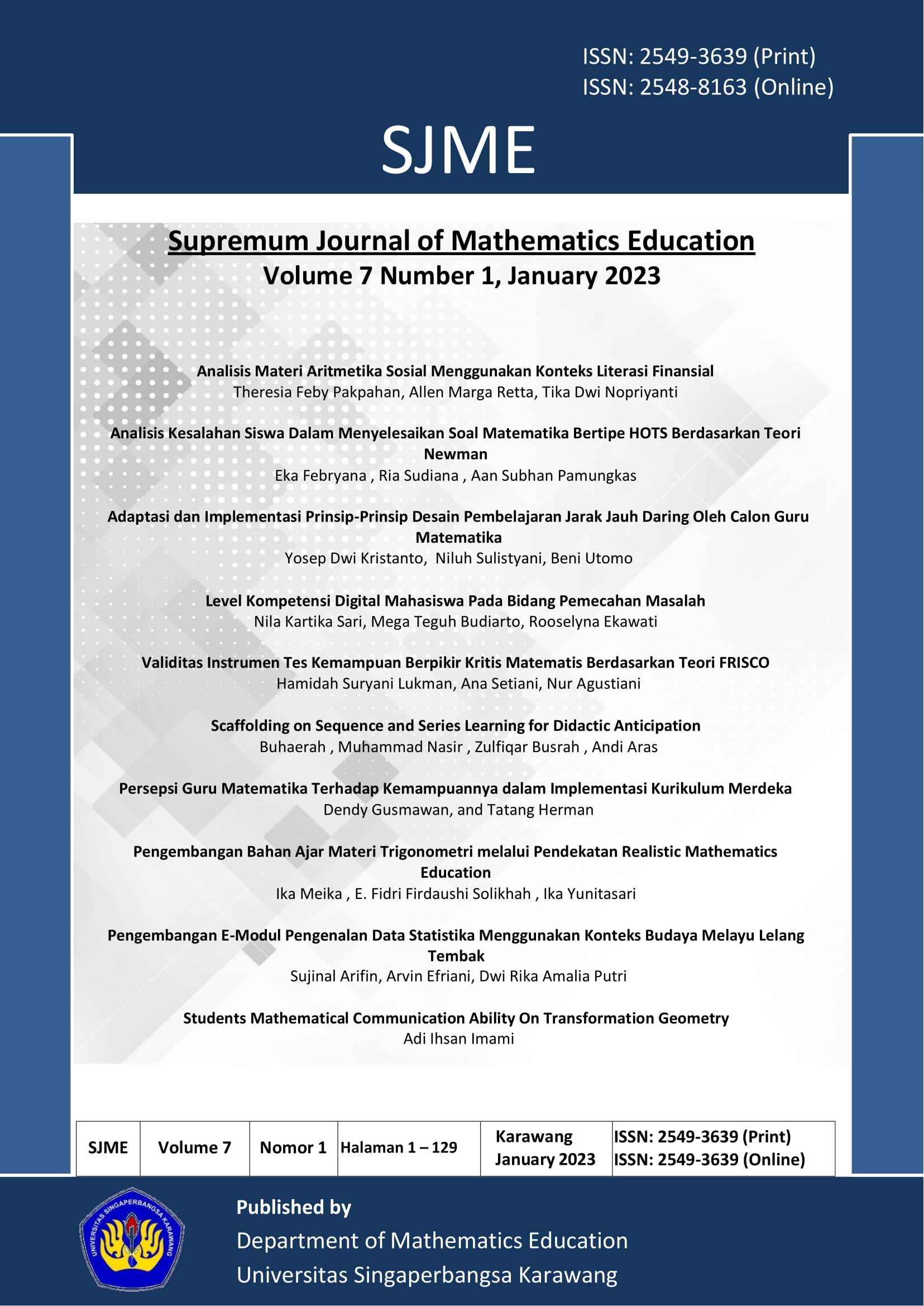Adaptasi dan Implementasi Prinsip-Prinsip Desain Pembelajaran Jarak Jauh Daring Oleh Calon Guru Matematika
DOI:
https://doi.org/10.35706/sjme.v7i1.6411Abstrak
Prinsip-prinsip desain pembelajaran jarak jauh daring yang telah dikembangkan pada penelitian sebelumnya perlu diselidiki proses adaptasi dan implementasinya. Proses tersebut memberikan wawasan penting untuk memperhalus dan memperbaiki prinsip-prinsip tersebut agar semakin sesuai dengan konteks pembelajaran. Tujuan penelitian ini adalah untuk mengetahui proses adaptasi dan implementasi prinsip-prinsip desain pembelajaran jarak jauh daring oleh para calon guru. Metode penelitian yang akan digunakan dalam penelitian ini adalah penelitian kualitatif yang didasarkan pada model teori aktivitas. Hasil penelitian ini mengungkap tantangan-tantangan yang dialami oleh para calon guru dalam mengadaptasi dan mengimplementasikan prinsip-prinsip desain pembelajaran jarak jauh daring. Selain itu, penelitian ini juga menemukan bahwa komunitas di sekitar calon guru memiliki peran yang penting dalam mendukungnya untuk mendesain dan mengimplementasikan pembelajaran jarak jauh daring.
Unduhan
Referensi
Agyei, D. D., & Voogt, J. (2012). Developing technological pedagogical content knowledge in pre-service mathematics teachers through collaborative design. Australasian Journal of Educational Technology, 28(4). https://doi.org/10.14742/ajet.827
Aidoo, B., Macdonald, M. A., Vesterinen, V.-M., Pétursdóttir, S., & Gísladóttir, B. (2022). Transforming Teaching with ICT Using the Flipped Classroom Approach: Dealing with COVID-19 Pandemic. Education Sciences, 12(6), 421. https://doi.org/10.3390/educsci12060421
Cheawjindakarn, B., Suwannatthachote, P., & Theeraroungchaisri, A. (2012). Critical Success Factors for Online Distance Learning in Higher Education: A Review of the Literature. Creative Education, 03(08), 61–66. https://doi.org/10.4236/ce.2012.38B014
Chen, Y. (2019). Effect of Mobile Augmented Reality on Learning Performance, Motivation, and Math Anxiety in a Math Course. Journal of Educational Computing Research, 57(7), 1695–1722. https://doi.org/10.1177/0735633119854036
Christidamayani, A. P., & Kristanto, Y. D. (2020). The Effects of Problem Posing Learning Model on Students’ Learning Achievement and Motivation. Indonesian Journal on Learning and Advanced Education (IJOLAE), 2(2), 100–108. https://doi.org/10.23917/ijolae.v2i2.9981
Creswell, J. W., & Poth, C. N. (2018). Qualitative inquiry & research design: Choosing among five approaches (Fourth edition). SAGE.
Dogan, M. F. (2020). Evaluating Pre-Service Teachers’ Design of Mathematical Modelling Tasks. International Journal of Innovation in Science and Mathematics Education, 28(1). https://doi.org/10.30722/IJISME.28.01.004
Engestrom, Y. (2000). Activity theory as a framework for analyzing and redesigning work. Ergonomics, 43(7), 960–974. https://doi.org/10.1080/001401300409143
Garrison, D. R. (2017). E-learning in the 21st century: A community of inquiry framework for research and practice (Third edition). Routledge.
Garrison, D. R., Anderson, T., & Archer, W. (1999). Critical Inquiry in a Text-Based Environment: Computer Conferencing in Higher Education. The Internet and Higher Education, 2(2–3), 87–105. https://doi.org/10.1016/S1096-7516(00)00016-6
Garzón, J., & Acevedo, J. (2019). Meta-analysis of the impact of Augmented Reality on students’ learning gains. Educational Research Review, 27, 244–260. https://doi.org/10.1016/j.edurev.2019.04.001
Geiger, V., Mulligan, J., Date-Huxtable, L., Ahlip, R., Jones, D. H., May, E. J., Rylands, L., & Wright, I. (2018). An interdisciplinary approach to designing online learning: Fostering pre-service mathematics teachers’ capabilities in mathematical modelling. ZDM, 50(1–2), 217–232. https://doi.org/10.1007/s11858-018-0920-x
iNACOL. (2011). National standards for quality online courses version 2. Author. http://www.inacol.org/wp-content/uploads/2015/02/national-standards-for-quality-online-courses-v2.pdf
Koehler, M. J., Mishra, P., Kereluik, K., Shin, T. S., & Graham, C. R. (2014). The Technological Pedagogical Content Knowledge Framework. In J. M. Spector, M. D. Merrill, J. Elen, & M. J. Bishop (Eds.), Handbook of Research on Educational Communications and Technology (pp. 101–111). Springer New York. https://doi.org/10.1007/978-1-4614-3185-5_9
Kristanto, Y. D. (2020). Upaya peningkatan kualitas pembelajaran matematika melalui flipped classroom dan gamifikasi: Suatu kajian pustaka. In PRISMA, Prosiding Seminar Nasional Matematika (Vol. 3, pp. 266–278). Jurusan Matematika FMIPA UNNES. https://journal.unnes.ac.id/sju/index.php/prisma/article/view/37596
Kristanto, Y. D., Niluh Sulistyani, & Utomo, B. (2021). Prinsip-Prinsip Desain Pembelajaran Jarak Jauh Daring (p. 2558592 Bytes). figshare. https://doi.org/10.6084/M9.FIGSHARE.14248940
Kristanto, Y. D., Utomo, B., & Sulistyani, N. (2021). Listening to the student voice on emergency remote teaching during the pandemic crisis. 5, 7–13. http://science.conference.upi.edu/proceeding/index.php/ICMScE/article/view/247
Lee, J. E., Recker, M., & Yuan, M. (2020). The Validity and Instructional Value of a Rubric for Evaluating Online Course Quality: An Empirical Study. Online Learning, 24(1). https://doi.org/10.24059/olj.v24i1.1949
Liu, Y., & Pásztor, A. (2022). Effects of problem-based learning instructional intervention on critical thinking in higher education: A meta-analysis. Thinking Skills and Creativity, 45, 101069. https://doi.org/10.1016/j.tsc.2022.101069
Loewenberg Ball, D., Thames, M. H., & Phelps, G. (2008). Content Knowledge for Teaching: What Makes It Special? Journal of Teacher Education, 59(5), 389–407. https://doi.org/10.1177/0022487108324554
Lowenthal, P., & Hodges, C. (2015). In Search of Quality: Using Quality Matters to Analyze the Quality of Massive, Open, Online Courses (MOOCs). The International Review of Research in Open and Distributed Learning, 16(5). https://doi.org/10.19173/irrodl.v16i5.2348
Meehan, M., & McCallig, J. (2019). Effects on learning of time spent by university students attending lectures and/or watching online videos. Journal of Computer Assisted Learning, 35(2), 283–293. https://doi.org/10.1111/jcal.12329
Niess, M. L. (2005). Preparing teachers to teach science and mathematics with technology: Developing a technology pedagogical content knowledge. Teaching and Teacher Education, 21(5), 509–523. https://doi.org/10.1016/j.tate.2005.03.006
Park, H., & Shea, P. (2020). A Ten-Year Review of Online Learning Research through Co-Citation Analysis. Online Learning, 24(2). https://doi.org/10.24059/olj.v24i2.2001
Permata, C. A. M., & Kristanto, Y. D. (2020). Desain Pembelajaran Matematika Berbasis Gamifikasi untuk Meningkatkan Minat Belajar Siswa. JNPM (Jurnal Nasional Pendidikan Matematika), 4(2), 279. https://doi.org/10.33603/jnpm.v4i2.3877
Quality Matters. (2019). Course Design Rubric Standards. https://www.qualitymatters.org/qa-resources/rubric-standards/k-12-secondary-rubric
Russell, D. L., & Schneiderheinze, A. (2005). Understanding Innovation in Education Using Activity Theory. Journal of Educational Technology & Society, 8(1), 38–53.
Saleem, A. N., Noori, N. M., & Ozdamli, F. (2022). Gamification Applications in E-learning: A Literature Review. Technology, Knowledge and Learning, 27(1), 139–159. https://doi.org/10.1007/s10758-020-09487-x
Setyani, G. D., & Kristanto, Y. D. (2020). A Case Study of Promoting Informal Inferential Reasoning in Learning Sampling Distribution for High School Students. SJME (Supremum Journal of Mathematics Education), 4(1), 64. https://doi.org/10.35706/sjme.v4i1.3132
Suliani, M., & Ahmad, A. M. (2021). Faktor yang Mempengaruhi Hasil Pembelajaran Jarak Jauh di MTs Negeri 6 HSS di Masa Pandemik Covid-19. SJME (Supremum Journal of Mathematics Education), 5(2). https://doi.org/10.35706/sjme.v5i2.5155
Sulistyani, N., Utomo, B., & Kristanto, Y. D. (2021). Emergency remote teaching experiences of mathematics education lectures to address COVID-19 pandemic. Journal of Physics: Conference Series, 1806(1), 012088. https://doi.org/10.1088/1742-6596/1806/1/012088
Valentine, D. (2002). Distance Learning: Promises, Problems, and Possibilities. Online Journal of Distance Learning Administration, 5(3).
Zimmerman, W., Altman, B., Simunich, B., Shattuck, K., & Burch, B. (2020). Evaluating Online Course Quality: A Study on Implementation of Course Quality Standards. Online Learning, 24(4). https://doi.org/10.24059/olj.v24i4.2325
##submission.downloads##
Diterbitkan
Cara Mengutip
Terbitan
Bagian
Lisensi

Artikel ini berlisensiCreative Commons Attribution-ShareAlike 4.0 International License.
Hak cipta dilindingi undang-undang berdasarkan Undang-undang Nomor 28 Tahun 2014 tentang Hak Cipta. Dilarang memperbanyak isi jurnal ini, baik sebagian maupun seluruhnya dalam bentuk apapun tanpa izin tertulis dari SJME (Supremum Journal of Mathematics Education) sebagai pemegang Hak Cipta terhadap seluruh isi dari jurnal tersebut.
Penulis yang menerbitkan jurnal ini setuju dengan persyaratan berikut:
- Penulis mempertahankan hak cipta dan memberikan hak jurnal tentang publikasi pertama dengan karya yang secara bersamaan dilisensikan di bawah Lisensi Atribusi Creative Commons yang memungkinkan orang lain membagikan karya tersebut dengan pengakuan dari karya penulis dan publikasi awal dalam jurnal ini.
- Penulis dapat memasukkan pengaturan kontrak tambahan yang terpisah untuk distribusi non-eksklusif dari versi terbitan jurnal tersebut (misalnya, kirimkan ke repositori institusional atau publikasikan dalam sebuah buku), dengan sebuah pengakuan atas publikasi awalnya di Jurnal ini.
- Penulis diizinkan dan didorong untuk memposting pekerjaan mereka secara online (misalnya di repositori institusional atau di situs web mereka) sebelum dan selama proses penyampaian, karena dapat menyebabkan pertukaran yang produktif, serta kutipan karya yang diterbitkan sebelumnya dan yang lebih lama.











